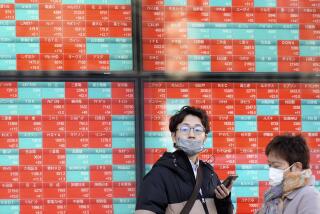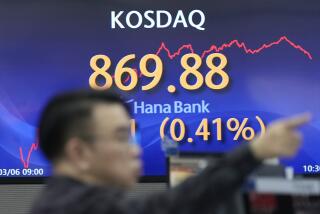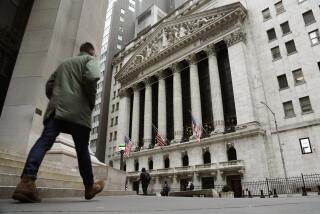Apple drags stocks lower as high-dividend companies also slip

U.S. stocks slipped Friday as Apple had its biggest decline in more than four years. Thanks to gains over the previous three days, the Standard & Poor’s 500 index still finished with its biggest weekly increase since March.
Apple, the world’s largest technology company, forecast weak revenue in the current quarter and startled investors by saying it will stop disclosing quarterly iPhone sales. That pulled technology stocks down. Other high-growth stocks held up well after the United States and China said they had made some progress in trade talks, and Asian indexes surged on reports that China’s government plans to cut taxes.
The Department of Labor said employers added 250,000 jobs in October, with no sign that hiring was going to slow down. The proportion of Americans with jobs is at its highest level since January 2009, and hourly wages also grew by the most since then. Along with high consumer confidence, those are all good signs for economic growth and consumer spending in the months to come.
Bond yields surged following the strong jobs report as investors bet on continued economic growth, which would push the Federal Reserve to raise interest rates more quickly.
“It clearly was a good report,” said David Lefkowitz, senior equity strategist Americas at UBS Global Wealth Management.
Growth in wages, while stronger than anything that’s been reported recently, was approximately what investors expected, Lefkowitz said. That’s important because investors are still sensitive to signs that inflation could flare up, which would force the Federal Reserve to be more aggressive in raising interest rates. If inflation grows moderately, as it appeared to do in October, such aggression is not as likely.
The S&P 500 index slid 17.31 points, or 0.6%, to 2,723.06 on Friday. The Dow Jones industrial average fell 109.91 points, or 0.4%, to 25,270.83.
The Nasdaq composite, which has a high concentration of technology companies, declined 77.06 points, or 1%, to 7,356.99. The Russell 2000 index of smaller-company stocks rose 3 points, or 0.2%, to 1,547.98.
Stocks had surged over the previous three days, and the S&P 500 finished the week with a rise of 2.4%. It had skidded in October, suffering its biggest monthly loss in seven years. The S&P 500 would have to rise an additional 7.6% to match the all-time high it reached Sept. 20.
Bond prices dropped, sending yields up sharply. The yield on the 10-year Treasury note jumped to 3.22% from 3.14%. A jump in interest rates last month started the market’s downturn, but investors didn’t seem as worried Friday. Interest rates will also be in focus when the Federal Reserve meets next week. The Fed is not expected to raise rates this month.
Apple’s sales in its latest quarter and its estimates for the holiday season disappointed investors. Other big smartphone makers don’t disclose how many phones they sell each quarter or what the sale price is.
The change raised suspicions that Apple might be trying to mask a downturn in the phone’s popularity. The company said those quarterly numbers don’t necessarily convey how strong its business has been.
Apple gets most of its revenue from iPhone sales, and lately it has boosted its profits by selling higher-priced models.
Company shares sagged 6.6% to $207.48. Chipmakers also fell. Qorvo slid 5.7% to $74, and Broadcom fell 4% to $220.77.
The governments of the United States and China said they were making some progress in trade talks. It has been months since the two sides made visible progress, and fears that the dispute was worsening contributed to global markets’ big October losses. Chinese state media also said President Xi Jinping promised tax cuts and other help to China’s entrepreneurs.
“In September, before earnings season started, the market was kind of complacent about tariff issues,” Lefkowitz said. “It’s something I think the market was ignoring and is now more attuned to.”
Germany’s DAX rose 0.4%. The CAC 40 in France advanced 0.3%. Britain’s FTSE 100 fell 0.3%.
The Hang Seng index in Hong Kong soared 4.2%. Japan’s Nikkei 225 index climbed 2.6%. South Korea’s Kospi surged 3.5%.
Starbucks jumped 9.7% to $64.32, its biggest gain since 2011, after it posted sales that were better than expected and said that customers spent more after it raised prices for brewed coffee. It also said that revenue from cold drinks improved, and that revenue improved in China.
Kraft Heinz sank 9.7% to $50.73, its biggest drop in three years, after its third-quarter profit fell far short of analyst forecasts. The maker of Oscar Mayer meats, Jell-O pudding and Velveeta cheese said that costs grew and that it’s continuing to make major investments in its business. Prices in the United States fell as stores ramped up discounts, especially for cheeses and drinks.
GoPro plunged 24.2% to $5.44 after the camera maker issued a revenue forecast for the current quarter that fell short of expectations.
Oil prices continued to decline. Benchmark U.S. crude slid 0.9% to $63.14 a barrel in New York. Brent crude slipped 0.1% to $72.83 a barrel in London.
Wholesale gasoline fell 0.5% to $1.71 a gallon. Heating oil fell 1.3% to $2.17 a gallon. Natural gas rose 1.5% to $3.28 per 1,000 cubic feet.
Gold fell 0.4% to $1,233.30 an ounce. Silver slipped 0.1% to $14.75 an ounce. Copper climbed 3.1% to $2.81 a pound.
The dollar rose to 113.28 yen from 112.69 yen. The euro fell to $1.1398 from $1.1409.
UPDATES:
2:50 p.m.: This article was updated with closing prices, context and analyst comment.
This article was originally published at 9 a.m.






